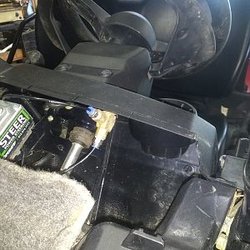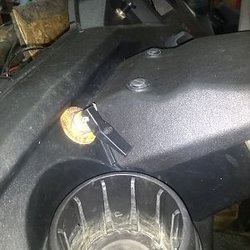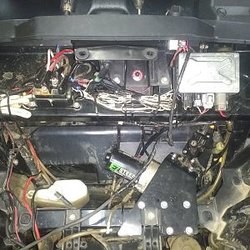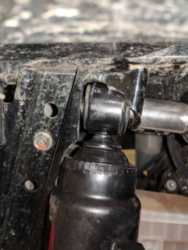Started this thread to put all the data, info, experiences, recommendations, etc., to install the Gabriel Hi-jackers(Part [HASHTAG]#49304[/HASHTAG]) or AC Delco air ride shocks (Part [HASHTAG]#504557[/HASHTAG]) to completely replace the stock P-500 shocks.
The least expensive, and simplest version of this set up, is to just replace the front shocks, have a single fill point, and a single valve to allow for isolating one side from the other, or allowing both sides to be joined, or 'see' each other. This set up also makes the most dramatic change in ride, and front suspension articulation, and is the biggest 'bang for the buck'.
**No matter what set up you end up going with, you MUST use doubled shocks at each wheel**
Adding the air shocks to the rear of the machine further improves ride, but not as dramatically as the front. This also adds cost (obviously) and complexity. If you normally carry alot of weight on the machine, the rear air-shocks may not serve you well with shock mounts in the stock location. I normally carry about 60-70 lbs on my cargo rack, and roughly 450 lbs riders and gear with no issues at all,(Note: my rear sway bar is removed) but the rear air pressure needs to be near 200psi to make changes on a slope, so an on-board 200psi compressor is really needed, as I've never seen a shop air compressor go above 140psi.
That being said, having '4 corner' air suspension opens up a whole new set of possible capabilities to the machine.
1- Allows for load compensation- side to side, and/or front to rear
2- Adjust ride quality for trail conditions or improved handling
3- Allows for better weight transfer on slopes to improve traction when ascending or descending steep terrain
4- Allows machine to be 'leaned' into a hill to reduce risk of rollovers in off camber situations.
5- Increases suspension travel by over 3" or a 50%+ improvement
6- Dramatic improvement in suspension articulation, with full control of all four wheels independently or in pairs front to rear.
7- Allows machine to be lowered to allow entry into height limited trailers, garages etc.
8- Can all be adjusted on the 'fly'
9- If bridged up or bottomed out, you can easily lift one wheel at a time, put fill under it, and the
machine can lift itself up off the obstacle.
The least expensive, and simplest version of this set up, is to just replace the front shocks, have a single fill point, and a single valve to allow for isolating one side from the other, or allowing both sides to be joined, or 'see' each other. This set up also makes the most dramatic change in ride, and front suspension articulation, and is the biggest 'bang for the buck'.
**No matter what set up you end up going with, you MUST use doubled shocks at each wheel**
Adding the air shocks to the rear of the machine further improves ride, but not as dramatically as the front. This also adds cost (obviously) and complexity. If you normally carry alot of weight on the machine, the rear air-shocks may not serve you well with shock mounts in the stock location. I normally carry about 60-70 lbs on my cargo rack, and roughly 450 lbs riders and gear with no issues at all,(Note: my rear sway bar is removed) but the rear air pressure needs to be near 200psi to make changes on a slope, so an on-board 200psi compressor is really needed, as I've never seen a shop air compressor go above 140psi.
That being said, having '4 corner' air suspension opens up a whole new set of possible capabilities to the machine.
1- Allows for load compensation- side to side, and/or front to rear
2- Adjust ride quality for trail conditions or improved handling
3- Allows for better weight transfer on slopes to improve traction when ascending or descending steep terrain
4- Allows machine to be 'leaned' into a hill to reduce risk of rollovers in off camber situations.
5- Increases suspension travel by over 3" or a 50%+ improvement
6- Dramatic improvement in suspension articulation, with full control of all four wheels independently or in pairs front to rear.
7- Allows machine to be lowered to allow entry into height limited trailers, garages etc.
8- Can all be adjusted on the 'fly'
9- If bridged up or bottomed out, you can easily lift one wheel at a time, put fill under it, and the
machine can lift itself up off the obstacle.
Last edited:





